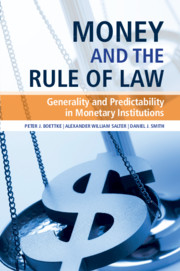Book contents
- Money and the Rule of Law
- Money and the Rule of Law
- Copyright page
- Dedication
- Contents
- Preface
- Acknowledgments
- 1 Introduction
- 2 Knowledge Problems with Discretionary Monetary Policy
- 3 Incentive Problems with Discretionary Central Banking
- 4 When Firefighters Are Arsonists
- 5 On the Shoulders of Giants
- 6 Money and the Rule of Law
- 7 Conclusion
- Index
- References
2 - Knowledge Problems with Discretionary Monetary Policy
Published online by Cambridge University Press: 13 May 2021
- Money and the Rule of Law
- Money and the Rule of Law
- Copyright page
- Dedication
- Contents
- Preface
- Acknowledgments
- 1 Introduction
- 2 Knowledge Problems with Discretionary Monetary Policy
- 3 Incentive Problems with Discretionary Central Banking
- 4 When Firefighters Are Arsonists
- 5 On the Shoulders of Giants
- 6 Money and the Rule of Law
- 7 Conclusion
- Index
- References
Summary
We analyze the information problems inherent in discretionary monetary policy. Discretionary central bankers confront immense informational burdens. Some of these are technical problems only, and can in principle be overcome. But there is also a genuine knowledge problem involved in discretionary monetary policy: reacting in real time to changes in the demand for money. This problem is unsolvable. It renders discretionary central banking systematically unlikely to achieve macroeconomic stability. In contrast, rules-based policy does not confront a knowledge problem.
- Type
- Chapter
- Information
- Money and the Rule of LawGenerality and Predictability in Monetary Institutions, pp. 22 - 57Publisher: Cambridge University PressPrint publication year: 2021

